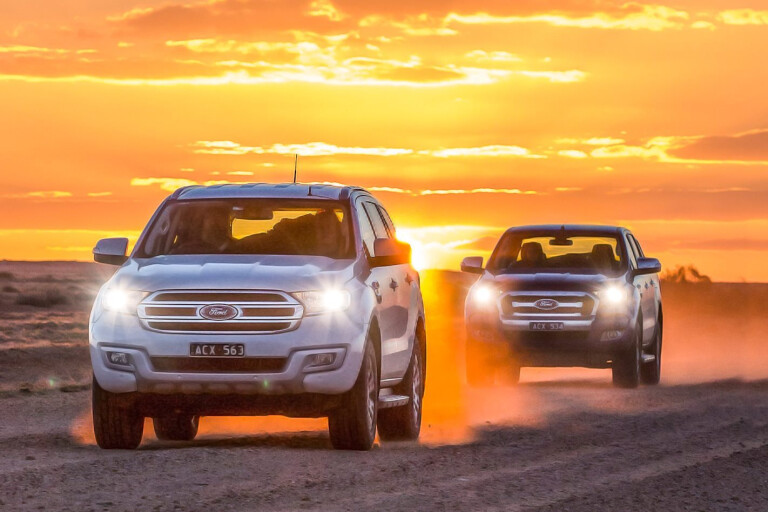
THE sales boom in one-tonne 4x4 utes has given the dwindling number of 4x4 wagons a reprieve, as wagon variants are spawned off the utes’ ladder chassis platforms.
This concept is nothing new and the Toyota 4Runner and Nissan Pathfinder are early examples of the breed.
These days we have a lot more manufacturers making the most of their ute platforms, with Toyota spinning the Fortuna off its Hilux, Holden its Trailblazer off the Colorado, Isuzu builds the MU-X off its D-Max and, most recently, Mitsubishi slipped the Triton’s chassis under its new Pajero Sport.
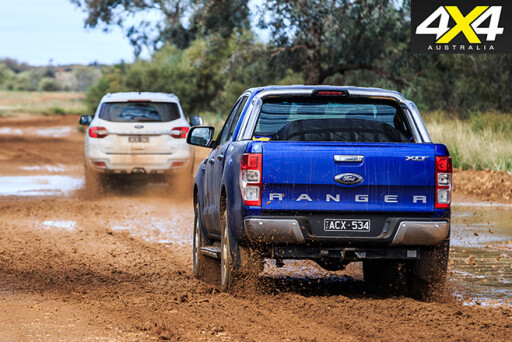 Then we have our two combatants here. Ford’s Everest wagon arrived in 2015 and was awarded 4X4 Australia’s 2015 4x4 Of The Year, in Trend specification. The Everest is derived off the PX Ranger ute chassis and gets there with a shortened wheelbase and coil springs taking the place of the ute’s leaves at the back. It shares much of its driveline with the Ranger.
Then we have our two combatants here. Ford’s Everest wagon arrived in 2015 and was awarded 4X4 Australia’s 2015 4x4 Of The Year, in Trend specification. The Everest is derived off the PX Ranger ute chassis and gets there with a shortened wheelbase and coil springs taking the place of the ute’s leaves at the back. It shares much of its driveline with the Ranger.
The Ranger was updated to PXII specification in 2015 and has since given the popular Hilux a run for its money on the sales charts, as buyers flock to its bold styling and relatively large diesel engine. It’s become a favourite with fleet buyers and enthusiasts alike and has outsold the class-leading Hilux on more than one occasion this year.
The popularity of the new utes, and the wagons derived from them, again raises the question of what works best for outback travel and off-road use. So, with an Everest Trend joining our long-term shed and a trip to Alice Springs for the Finke Desert Race ahead of us, 4X4 Australia rounded up a Ranger XLT to join us on the run up the Oodnadatta Track.
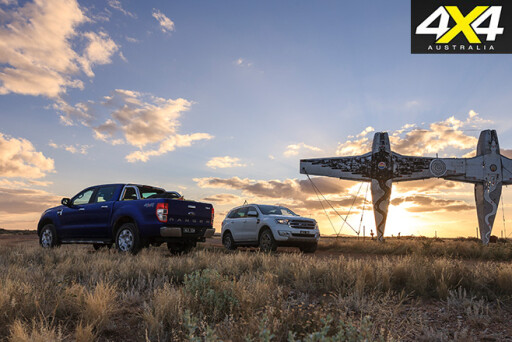
THE SAME BUT DIFFERENT
THE Everest and Ranger share platforms and many components, but there are differences between how they are used for the respective wagon and ute. The ladder chassis under the Everest, for example, has a 370mm shorter wheelbase. Under the rear, the ute uses leaf springs while the wagon rides on coils located with a multi-link and Watts linkage set-up.
Both the ute and wagon share the same independent wishbone and coil-spring front suspension, but with model-specific calibrations for spring and shock rates.
Both vehicles tested here use the 3.2-litre five-cylinder Ford diesel engine and six-speed auto combination. The turbocharged engine makes 470Nm in both cars, but in the Everest it is tuned to make 4kW less at 143kW. This is due to the wagon’s use of extra emissions devices such as selective catalytic reduction (SCR).
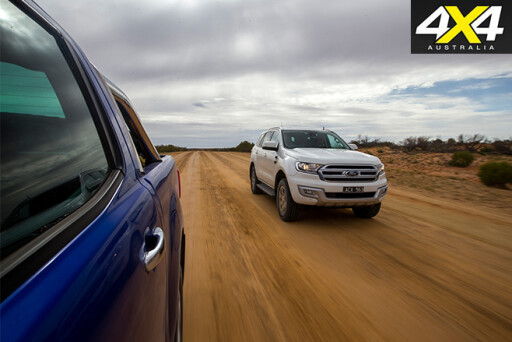 The drivelines are further differentiated with the Ranger being a conventional part-time 4x4 system, while the Everest has a full-time 4x4 system that splits torque on demand. The full-time system also gets a multi-terrain system that optimises the centre differential and other chassis systems to best suit different terrains at the turn of a dial. Both vehicles employ a dual-range transfer case with 2.7171:1 low range.
The drivelines are further differentiated with the Ranger being a conventional part-time 4x4 system, while the Everest has a full-time 4x4 system that splits torque on demand. The full-time system also gets a multi-terrain system that optimises the centre differential and other chassis systems to best suit different terrains at the turn of a dial. Both vehicles employ a dual-range transfer case with 2.7171:1 low range.
The Ranger and Everest also share much of their front-end sheetmetal and interior, with only minor differences for model and specification. Things like the grille and front bumper are different for each vehicle, while the dashboards and AV hardware are pretty much the same.
EVEREST TREND WAGON: PROS

THE wagon brings a more refined ride and cabin, improved safety, better dynamics, increased seating capacity and better off-road ability.
The Everest’s cabin benefits from more sound insulation material than the Ranger and it utilises a clever active noise reduction system, that works like noise-cancelling headphones, to reduce the amount of ambient noise that reaches the cabin.
Despite using a near identical driveline, the inside of the Everest is a quieter place than the Ranger. Our Everest also has more aggressive all-terrain tyres fitted than the Ranger’s OE rubber but still rides quiet.
 The wagon’s cargo area might be smaller than the ute’s, but it’s enclosed in the cabin so it offers much more security and weather protection for valuable items.
The wagon’s cargo area might be smaller than the ute’s, but it’s enclosed in the cabin so it offers much more security and weather protection for valuable items.
The Everest’s full-time drive system makes the vehicle more surefooted on all terrains, which makes it safer both on- and off-road for all occupants – of which it can carry seven, opposed to the Ranger’s five.
That same full-time drive system makes manoeuvring the Everest when off-road or on tight tracks easier, as the centre diff is not locked when in 4x4 high-range. Drive the cars back-to-back on tight tracks, or when shuffling them around for a photoshoot like we do, and you really notice what a huge difference this makes.
 The Everest is shorter overall than the Ranger, making it easier to manoeuvre than the ute, and all Everests have a rear view camera for parking. Likewise, its shorter wheelbase gives it a tighter turning radius, 11.7 metres versus 12.7 metres for the Ranger, and improves its ability over bumps and ruts by upping the ramp-over angle.
The Everest is shorter overall than the Ranger, making it easier to manoeuvre than the ute, and all Everests have a rear view camera for parking. Likewise, its shorter wheelbase gives it a tighter turning radius, 11.7 metres versus 12.7 metres for the Ranger, and improves its ability over bumps and ruts by upping the ramp-over angle.
EVEREST TREND WAGON: CONS
THE obvious con for any wagon is payload.
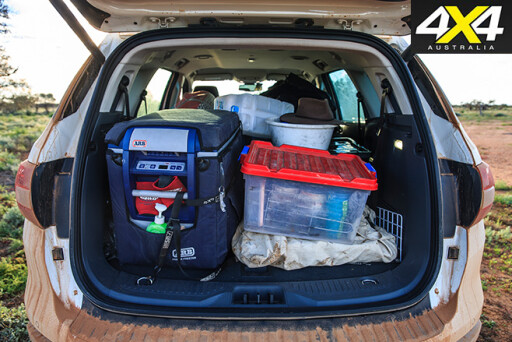 The wagon can’t match the ute’s one-tonne capacity, while the carpeted cargo area in the Everest isn’t receptive to loads of sand, gravel and firewood. Nor are things like dirt bikes, timber or other large objects easily accommodated in the back of the wagon.
The wagon can’t match the ute’s one-tonne capacity, while the carpeted cargo area in the Everest isn’t receptive to loads of sand, gravel and firewood. Nor are things like dirt bikes, timber or other large objects easily accommodated in the back of the wagon.
Not only is the load capacity lower but the rated towing mass also falls 500kg shy of the Ranger’s.
RANGER XLT UTE: PROS
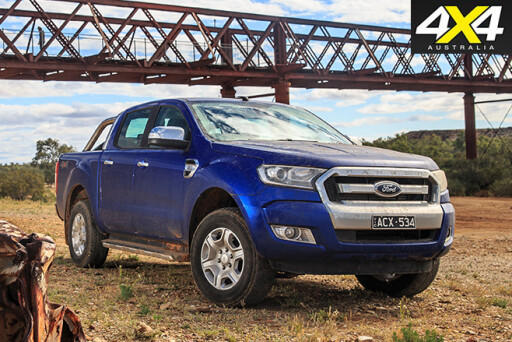
The ute offers far superior load carrying ability for bigger, heavier and dirtier cargo. If security or exposure to weather is an issue for your gear then you can always add a tonneau cover, hard lid or even a canopy to protect your load. The longer vehicle also lets you carry longer items such as timber or ladders on the appropriate roof racks and at the back of the tray.
With the right accessories the ute offers more options and much more versatility for carrying stuff – and then you can add that extra 500kg of capacity on the trailer.
Another plus for the Ranger is that it is available with a six-speed manual transmission, while the six-speed automatic is an extra $2270. In contrast, the Everest is only available with an automatic transmission.
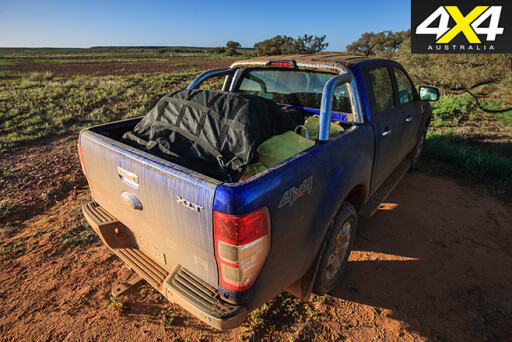 RANGER XLT UTE: CONS
RANGER XLT UTE: CONS
WHILE the Ranger gets all the benefits behind the cabin, its negatives come inside it. The standard of 4x4 utes might have come a long way in recent years, but they still can’t match the similar spec wagons for comfort and refinement.
Again, after driving the two Fords back-to-back, the Ranger is noticeably noisier inside. Ford even skimps further on sound deadening material the further you go down the Ranger model list, so the XLT is near the top and gets most of the insulation.
 The back seat in the crew-cab Ranger is very upright and isn’t adjustable like the Everest’s second row. As such, it’s not as accommodating or comfortable over longer drives. And, of course, there are only two rows in the ute.
The back seat in the crew-cab Ranger is very upright and isn’t adjustable like the Everest’s second row. As such, it’s not as accommodating or comfortable over longer drives. And, of course, there are only two rows in the ute.
All the benefits of the Everest’s full-time 4x4 system are obviously negatives for the Ranger’s part-time, unless you consider the use of two-wheel drive a benefit. One plus is that the ute tends to have more practical wheel and tyre sizes, and the XLT Ranger rides on 17s while the Everest is on 18s.
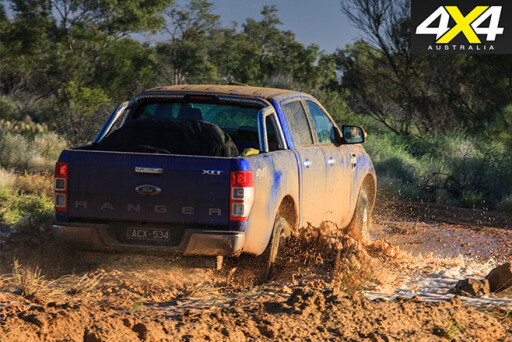 Only the top-spec Ranger Wildtrak gets 18s, but you’re better off with the smaller wheels. In comparison, the top-spec Everest Titanium rolls on silly 20-inch wheels.
Only the top-spec Ranger Wildtrak gets 18s, but you’re better off with the smaller wheels. In comparison, the top-spec Everest Titanium rolls on silly 20-inch wheels.
Another small win for the ute is its lower crawl gear, thanks to its lower final-drive ratio.
A WAGON, OR A UTE?
SO, which of these two Fords is the better vehicle for outback travel? There are two factors here that are non-negotiable when making your buying choice. One: if you have a family and need three rows of seats, then the Everest is for you. Two: if you need to carry bigger, heavier loads like dirt bikes or building supplies, then the Ranger is your only choice.
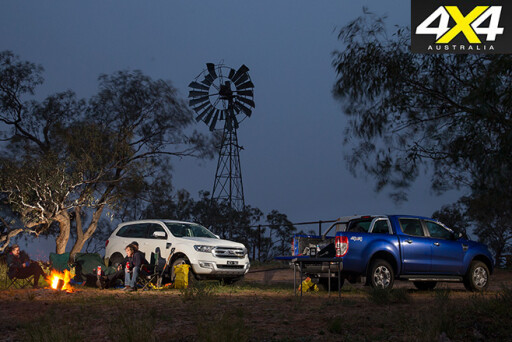 But let’s consider the options for the two-up tourer. The Everest wagon delivers more comfort, safety and security, with better dynamics, off-road ability and fuel economy. The Ranger XLT auto might cost around $4500 less than the Everest Trend, but unless you specifically need the load-lugging ability of a tray, then the wagon will always be the better choice.
But let’s consider the options for the two-up tourer. The Everest wagon delivers more comfort, safety and security, with better dynamics, off-road ability and fuel economy. The Ranger XLT auto might cost around $4500 less than the Everest Trend, but unless you specifically need the load-lugging ability of a tray, then the wagon will always be the better choice.
Talking of purchase price, with wagons being less popular than utes at the moment, you’ll probably have more bargaining power with the Everest at the dealer.
SPECS
| EVEREST TREND ($60,990) | RANGER XLT ($56,990) | |
| Engine | I5 turbo-diesel | I5 turbo-diesel |
| Capacity | 3198cc | 3198cc |
| Max Power | 143kw @ 3000rpm | 147kW @ 3000rpm |
| Max Torque | 470nm @1750-2500 rpm | 470nm @ 1500-2750rpm |
| Gearbox | six-speed auto | six-speed auto |
| Crawl Ratio | 38.61:1 | 42.27:1 |
| 4x4 System | Full-time, 2-speed | Part-time, 2-speed |
| Construction | 5-door wagon or ladder frame | 4-door ute on ladder frame |
| Front Suspension | Independent coils and wishbones | Indie coils and wishbones |
| Rear suspension | Live axle on coils and multilink | Live axle on leaf springs |
| Wheel and tyre spec | 265/65-R18 | 265/70 R17 |
| kerb weight | 2407kg | 2159kg |
| GVM | 3100kg | 3200kg |
| Payload | 693kg | 1041kg |
| Towing Capcity | 3000kg | 3500kg |
| Seating capacity | Seven | Five |
| Fuel tank capacity | 80L | 80L |
| ADR fuel consumption | 8.5L/100km | 9.2L/100km |
*Australian Design Rule 'Combined cycle'



COMMENTS